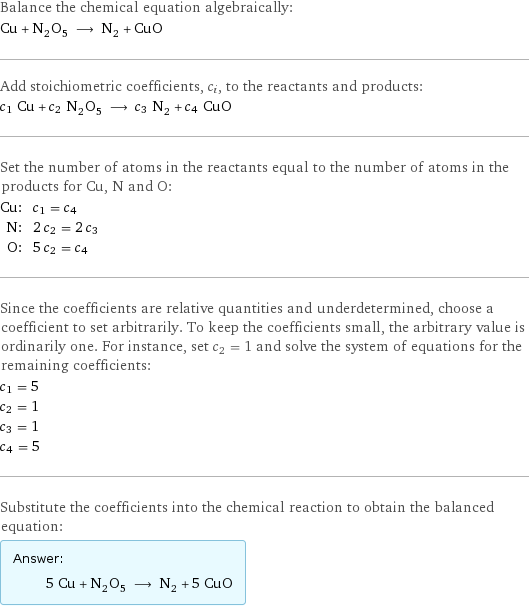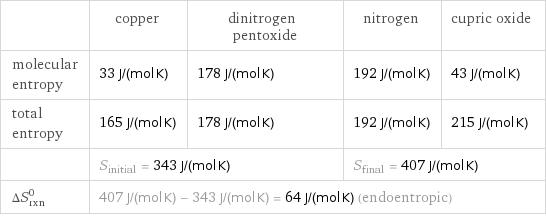Input interpretation

Cu copper + N_2O_5 dinitrogen pentoxide ⟶ N_2 nitrogen + CuO cupric oxide
Balanced equation

Balance the chemical equation algebraically: Cu + N_2O_5 ⟶ N_2 + CuO Add stoichiometric coefficients, c_i, to the reactants and products: c_1 Cu + c_2 N_2O_5 ⟶ c_3 N_2 + c_4 CuO Set the number of atoms in the reactants equal to the number of atoms in the products for Cu, N and O: Cu: | c_1 = c_4 N: | 2 c_2 = 2 c_3 O: | 5 c_2 = c_4 Since the coefficients are relative quantities and underdetermined, choose a coefficient to set arbitrarily. To keep the coefficients small, the arbitrary value is ordinarily one. For instance, set c_2 = 1 and solve the system of equations for the remaining coefficients: c_1 = 5 c_2 = 1 c_3 = 1 c_4 = 5 Substitute the coefficients into the chemical reaction to obtain the balanced equation: Answer: | | 5 Cu + N_2O_5 ⟶ N_2 + 5 CuO
Structures

+ ⟶ +
Names

copper + dinitrogen pentoxide ⟶ nitrogen + cupric oxide
Reaction thermodynamics
Enthalpy

| copper | dinitrogen pentoxide | nitrogen | cupric oxide molecular enthalpy | 0 kJ/mol | -43.1 kJ/mol | 0 kJ/mol | -157.3 kJ/mol total enthalpy | 0 kJ/mol | -43.1 kJ/mol | 0 kJ/mol | -786.5 kJ/mol | H_initial = -43.1 kJ/mol | | H_final = -786.5 kJ/mol | ΔH_rxn^0 | -786.5 kJ/mol - -43.1 kJ/mol = -743.4 kJ/mol (exothermic) | | |
Entropy

| copper | dinitrogen pentoxide | nitrogen | cupric oxide molecular entropy | 33 J/(mol K) | 178 J/(mol K) | 192 J/(mol K) | 43 J/(mol K) total entropy | 165 J/(mol K) | 178 J/(mol K) | 192 J/(mol K) | 215 J/(mol K) | S_initial = 343 J/(mol K) | | S_final = 407 J/(mol K) | ΔS_rxn^0 | 407 J/(mol K) - 343 J/(mol K) = 64 J/(mol K) (endoentropic) | | |
Equilibrium constant
![Construct the equilibrium constant, K, expression for: Cu + N_2O_5 ⟶ N_2 + CuO Plan: • Balance the chemical equation. • Determine the stoichiometric numbers. • Assemble the activity expression for each chemical species. • Use the activity expressions to build the equilibrium constant expression. Write the balanced chemical equation: 5 Cu + N_2O_5 ⟶ N_2 + 5 CuO Assign stoichiometric numbers, ν_i, using the stoichiometric coefficients, c_i, from the balanced chemical equation in the following manner: ν_i = -c_i for reactants and ν_i = c_i for products: chemical species | c_i | ν_i Cu | 5 | -5 N_2O_5 | 1 | -1 N_2 | 1 | 1 CuO | 5 | 5 Assemble the activity expressions accounting for the state of matter and ν_i: chemical species | c_i | ν_i | activity expression Cu | 5 | -5 | ([Cu])^(-5) N_2O_5 | 1 | -1 | ([N2O5])^(-1) N_2 | 1 | 1 | [N2] CuO | 5 | 5 | ([CuO])^5 The equilibrium constant symbol in the concentration basis is: K_c Mulitply the activity expressions to arrive at the K_c expression: Answer: | | K_c = ([Cu])^(-5) ([N2O5])^(-1) [N2] ([CuO])^5 = ([N2] ([CuO])^5)/(([Cu])^5 [N2O5])](../image_source/dea3f9424d68ac278108186a1f9c098d.png)
Construct the equilibrium constant, K, expression for: Cu + N_2O_5 ⟶ N_2 + CuO Plan: • Balance the chemical equation. • Determine the stoichiometric numbers. • Assemble the activity expression for each chemical species. • Use the activity expressions to build the equilibrium constant expression. Write the balanced chemical equation: 5 Cu + N_2O_5 ⟶ N_2 + 5 CuO Assign stoichiometric numbers, ν_i, using the stoichiometric coefficients, c_i, from the balanced chemical equation in the following manner: ν_i = -c_i for reactants and ν_i = c_i for products: chemical species | c_i | ν_i Cu | 5 | -5 N_2O_5 | 1 | -1 N_2 | 1 | 1 CuO | 5 | 5 Assemble the activity expressions accounting for the state of matter and ν_i: chemical species | c_i | ν_i | activity expression Cu | 5 | -5 | ([Cu])^(-5) N_2O_5 | 1 | -1 | ([N2O5])^(-1) N_2 | 1 | 1 | [N2] CuO | 5 | 5 | ([CuO])^5 The equilibrium constant symbol in the concentration basis is: K_c Mulitply the activity expressions to arrive at the K_c expression: Answer: | | K_c = ([Cu])^(-5) ([N2O5])^(-1) [N2] ([CuO])^5 = ([N2] ([CuO])^5)/(([Cu])^5 [N2O5])
Rate of reaction
![Construct the rate of reaction expression for: Cu + N_2O_5 ⟶ N_2 + CuO Plan: • Balance the chemical equation. • Determine the stoichiometric numbers. • Assemble the rate term for each chemical species. • Write the rate of reaction expression. Write the balanced chemical equation: 5 Cu + N_2O_5 ⟶ N_2 + 5 CuO Assign stoichiometric numbers, ν_i, using the stoichiometric coefficients, c_i, from the balanced chemical equation in the following manner: ν_i = -c_i for reactants and ν_i = c_i for products: chemical species | c_i | ν_i Cu | 5 | -5 N_2O_5 | 1 | -1 N_2 | 1 | 1 CuO | 5 | 5 The rate term for each chemical species, B_i, is 1/ν_i(Δ[B_i])/(Δt) where [B_i] is the amount concentration and t is time: chemical species | c_i | ν_i | rate term Cu | 5 | -5 | -1/5 (Δ[Cu])/(Δt) N_2O_5 | 1 | -1 | -(Δ[N2O5])/(Δt) N_2 | 1 | 1 | (Δ[N2])/(Δt) CuO | 5 | 5 | 1/5 (Δ[CuO])/(Δt) (for infinitesimal rate of change, replace Δ with d) Set the rate terms equal to each other to arrive at the rate expression: Answer: | | rate = -1/5 (Δ[Cu])/(Δt) = -(Δ[N2O5])/(Δt) = (Δ[N2])/(Δt) = 1/5 (Δ[CuO])/(Δt) (assuming constant volume and no accumulation of intermediates or side products)](../image_source/746872af3c2903a8667d1b2348766739.png)
Construct the rate of reaction expression for: Cu + N_2O_5 ⟶ N_2 + CuO Plan: • Balance the chemical equation. • Determine the stoichiometric numbers. • Assemble the rate term for each chemical species. • Write the rate of reaction expression. Write the balanced chemical equation: 5 Cu + N_2O_5 ⟶ N_2 + 5 CuO Assign stoichiometric numbers, ν_i, using the stoichiometric coefficients, c_i, from the balanced chemical equation in the following manner: ν_i = -c_i for reactants and ν_i = c_i for products: chemical species | c_i | ν_i Cu | 5 | -5 N_2O_5 | 1 | -1 N_2 | 1 | 1 CuO | 5 | 5 The rate term for each chemical species, B_i, is 1/ν_i(Δ[B_i])/(Δt) where [B_i] is the amount concentration and t is time: chemical species | c_i | ν_i | rate term Cu | 5 | -5 | -1/5 (Δ[Cu])/(Δt) N_2O_5 | 1 | -1 | -(Δ[N2O5])/(Δt) N_2 | 1 | 1 | (Δ[N2])/(Δt) CuO | 5 | 5 | 1/5 (Δ[CuO])/(Δt) (for infinitesimal rate of change, replace Δ with d) Set the rate terms equal to each other to arrive at the rate expression: Answer: | | rate = -1/5 (Δ[Cu])/(Δt) = -(Δ[N2O5])/(Δt) = (Δ[N2])/(Δt) = 1/5 (Δ[CuO])/(Δt) (assuming constant volume and no accumulation of intermediates or side products)
Chemical names and formulas

| copper | dinitrogen pentoxide | nitrogen | cupric oxide formula | Cu | N_2O_5 | N_2 | CuO name | copper | dinitrogen pentoxide | nitrogen | cupric oxide IUPAC name | copper | nitro nitrate | molecular nitrogen |
Substance properties

| copper | dinitrogen pentoxide | nitrogen | cupric oxide molar mass | 63.546 g/mol | 108.01 g/mol | 28.014 g/mol | 79.545 g/mol phase | solid (at STP) | solid (at STP) | gas (at STP) | solid (at STP) melting point | 1083 °C | 30 °C | -210 °C | 1326 °C boiling point | 2567 °C | 47 °C | -195.79 °C | 2000 °C density | 8.96 g/cm^3 | 2.05 g/cm^3 | 0.001251 g/cm^3 (at 0 °C) | 6.315 g/cm^3 solubility in water | insoluble | | insoluble | insoluble surface tension | | | 0.0066 N/m | dynamic viscosity | | | 1.78×10^-5 Pa s (at 25 °C) | odor | odorless | | odorless |
Units
